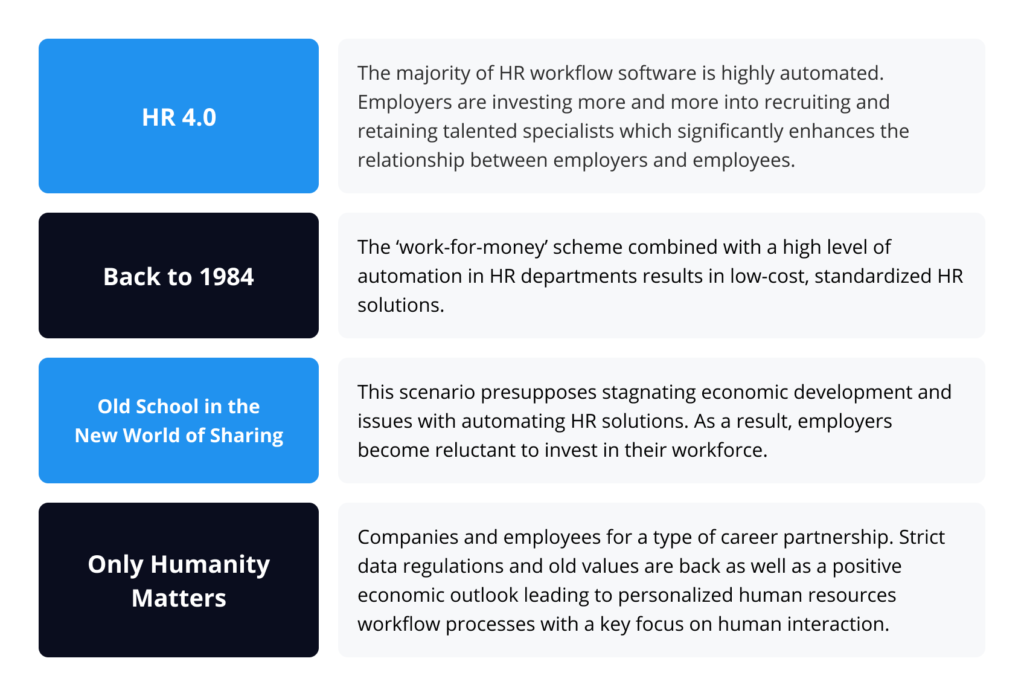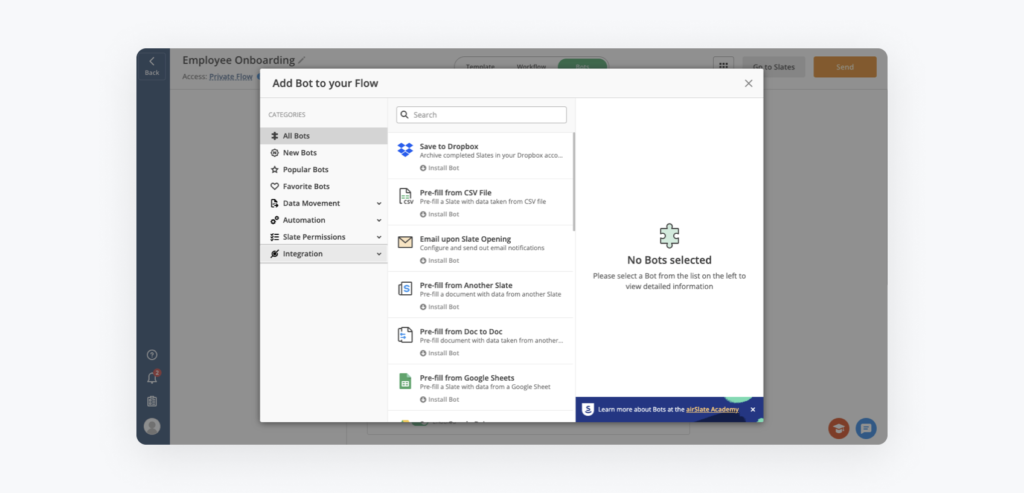HR automation: 3 airSlate workflows for human resources and recruitment professionals

HR departments have a tremendous impact on an organization’s bottom line. That’s why businesses need to maintain a robust infrastructure for HR processes. This is where HR automation – one of the latest technological developments for business process management — comes into play.
The key bottlenecks of HR workflows include (but are not limited to) excessive paperwork, data errors, redundant and duplicate work, inefficient use of resources, low employee morale, and many others. So, is it possible to address all of these issues with just one solution? As it turns out, there is!
In this blog, we’ll provide you with comprehensive information on how HR automation software helps businesses and describe the three most typical workflows for HR departments that can be automated with airSlate within minutes.
Take note, airSlate offers a library of ready-to-use flow templates for HR processes. But more on that later.
What is an HR workflow?
A human resources workflow involves processing documents such as performance reviews, timesheets, onboarding documentation, sick leaves, or various surveys as well as submitting, approving, and tracking HR requests — all in one platform. In simple terms, it’s a set of routine, repetitive tasks related to document processing. Thus, as soon as a workflow starts, the HR manager is already aware of every step that comes next. However, this doesn’t make the human resources management process easier: a typical HR workflow, e.g., employee onboarding, can contain a number of documents as well as routing that goes back and forth between the newcomer, HR department, project manager, etc.
What does HRM mean?
HRM, or human resource management, is the practice of recruiting, hiring and managing employees within an organization. #nocode #automation Share on XLet’s have a look at the most typical human resources tasks and why automation is so critical to their success.
1. Onboarding new employees
The first step in managing human resources is onboarding new workers. HR managers not only need to provide newcomers with all the necessary documents (e.g., labor agreement) and get them signed, but also make sure the new employees are aware of the company’s policies, values, code of conduct, etc. Sending out every document manually, as well as checking whether all of them have been filled out and signed, is time-consuming and prone to error. By automating document routing, HR departments can devote more time to personal communication with newbies, thus helping them to adapt much faster and without stress.
2. Collecting employee surveys
HR departments have to deal with various types of surveys on a regular basis. These can be employee engagement surveys, employee performance surveys, professional development surveys, 360 surveys, employee opinion/satisfaction surveys, and many others. All of them have a similar workflow: the HR manager sends out the surveys so that employees fill them out and send them back. Automation is of high importance here because it ensures that all the fields in a survey are completed and nobody forgets to fill it out thanks to automatic notifications and reminders.
3. Managing employee requests
Employee requests can have many different purposes: business trips, vacations, sick leave, and so on. Processing them is a human resources task. The key challenge here is routing documents and transferring data. Workflow automation eliminates the risk of directing a document to the wrong recipient and significantly reduces the time it takes to complete a process by instantly transferring the necessary information between documents and systems of record.
4. Managing incident reports
From time to time, incidents are bound to occur at the workplace, regardless of the industry. To minimize the damage, it is necessary to analyze the situation, interview the people involved, and create a detailed report to help solve the issue and prevent it from recurring. Automation helps structure the process, collect, route, and sort all the necessary data to respond to the incident as soon as possible.
The above-mentioned examples as well as other human resources business processes have a more or less similar pattern. But before detailing the benefits of automation for HR workflows, let’s have a look at some statistics and research data to better understand why the future of human resource management is inconceivable without automation.
According to Deloitte, there are four possible scenarios for HR development within the upcoming decade:

As you can see, the majority of the scenarios above imply automation and there’s a good reason for that.
This HR flowchart will help you better understand the difference between manual and automated HR processes.


How well do you know HR processes? Test yourself.
Which of the following is NOT a process within an information system for human resource management?
- Staff training
- Peer review
- Firing decisions
- Recruitment process
*Find the correct answer at the end of this blog.
Every HR manager spends at least 8 hours per week completing manual and repetitive tasks. Plus, HR managers deal with the lion’s share of employee information and end up having to overcome a variety of challenges. Learn how to boost the efficiency of an HR Department in your organisation with the airSlate Academy:
How to assess the workflow automation needs of HR?
The future of human resource management is impossible without workflow automation. It’s a great option for reducing manual work in HR processes. However, it cannot replace HR managers completely. Keep this in mind when assessing the workflow automation needs of the human resources department at your organization.
Have a look at the diagram below to better understand which human resource activities can and should be automated in comparison to those that can’t.

Certainly, there are many more examples of HR workflows but even those presented above show that all the processes, except in-person communication or creative work, can and should be automated.
The next step is to put these workflows in the order of priority. And finally, identify which processes at the top of this list consume the most time.
According to a 2020 KPMG report, which involved over 1,200 HR executives globally, over ⅔ of respondents agreed that the human resources field is undergoing digital transformation. However, only 480 of them admitted to having a digital work plan at their organization.
Once you’ve identified the key inefficiencies, it’s time to select a tool for digital workflow automation that will help you address these issues. Here are some tips that will help you choose the right software for your human resources workflows.
- No-code automation
No-code software is worth paying attention to because your HR managers are unlikely to have coding experience and you probably don’t want to spend the extra money on outsourcing developers to help you set up automated HR systems.
No-code platforms allow you and your team members to build full-fledged automated workflows of any complexity without any coding skills. #nocode #automation Share on X- Cloud service integrations
Document sorting and storage is one of the key challenges HR departments face on a regular basis. The issue can be easily resolved with an HR automation software that supports integrations with cloud services like Google Drive, OneDrive, Box, and others. With such a tool, documents are automatically updated, attached, transferred, and saved to the selected folder of the cloud service you’re using.
- Workflow visualization
This feature might not seem crucial at first glance, but imagine that you can see the entire process right in front of you, visualized as a diagram (with all the participants, documents, access permissions, etc.). You can drag and drop the steps of the diagram to build document routing, add names to these steps to make it understandable for you and your team, assign fields in documents to specific recipients, set up conditions for the document to be sent to this or that recipient, and more.

- Training resources
Any software (including automated human resources systems), even the most user-friendly and intuitive ones, require instructions in order to work with a certain feature. Check if the HR automation software has dedicated training or courses to teach you and your team members how to work with their product. Also, check if these courses are free or you’ll have to pay extra.
3 airSlate Flow Templates for workflow automation in HR
As an all-in-one workflow automation software, airSlate has plenty of HR automation ideas for almost every business process within an HR department. We’ve compiled the top 3 most popular airSlate examples of automated HR experience that are relevant to any industry and organization.
Get familiar with the full list of flow templates dedicated to HR workflows in the airSlate library under the Human resources category.
1. Employee Onboarding Flow Template
Any person can start their journey in a company from the onboarding stage. With airSlate, this process goes fast, smooth, and stress-free for both newcomers and HR managers.
- Get registered with airSlate and create your Workspace.

- Select the Flow Template library within your Workspace. Since Employee Onboarding is one of the most popular workflows, you’ll see this template on the initial page. Click on it, then click Import.

- Edit the existing documents or add more, if needed.

- Visualize the process with the airSlate drag-and-drop workflow diagram. The Employee Onboarding Flow Template already contains a default diagram for this workflow but you can change and customize it the way you need: add or remove Steps, assign documents, change access permissions, and more.

- Install and configure airSlate Bots to automatically transfer data, send notifications, archive completed documents, and more. Use the Bots that are included in the flow template or add new ones. Every airSlate Bot is no-code. Meaning, their configuration doesn’t require any coding skills.

That’s it! Just click the Send button and share your flow template with the specified recipients or create a sharable link to the flow template.
If you want to get detailed, step-by-step guidance on how to set up an Employee Onboarding Flow Template, the airSlate Academy has prepared a dedicated Employee Onboarding course that you can access for free.
2. Vacation/Leave Request Flow Template
Vacation is an integral part of the working process, regardless of the position or industry. Besides, occasional one-two day leave requests from employees are also quite common for HR departments. That’s why airSlate prepared a separate flow template that is dedicated to requesting vacation or leave.
The workflow template is very similar to that of the previous flow template. The only differences are:
- the documents to be used (you can add any document to the vacation request workflow but the default one in this Template is a Vacation Request form)
- The workflow Steps and access permissions you assign (you can add the Steps you need and assign documents to them. The most typical Steps for this flow template are Requester and Manager as well as a branch for two possible outcomes: if the request has been approved or not):

- The Bots to add (the Template already has several Bots added by default, but you can remove them and add other Bots if needed)
Once the Template is configured, share it the same way as you did with the Employee Onboarding Flow Template.
3. Leave of Absence Request Flow Template
The final Template we’ll discuss is very similar to the previous one. The Leave of Absence Request Flow Template is also about taking some time off work. However, unlike the Vacation/Leave Request Flow Template, it doesn’t involve financial reimbursement. Thus, this HR workflow process template is slightly different, namely:
- the document to use (this flow template contains a Leave of absence request form as the default document, which you can replace or edit however you need)
- the workflow Steps and access permissions you assign (you can add the Steps you need and assign documents to them; this flow template contains two default Steps — Requester and Approver)
- The Bots to add (the flow template already contains a long list of Bots which you can configure, add new Bots, or remove any unnecessary ones):

The bottom line
No matter which industry you work in, education, healthcare, IT, etc., — the human resources department is an integral part of your organization. By automating HR processes with airSlate, you not only increase efficiency and eliminate endless paperwork for HR managers but also reduce the levels of stress for both newcomers and existing employees.
*Quiz answer: Firing decisions
Stay tuned! Our upcoming posts will provide you with more information on the most popular workflows that other industries automate.
It’s worth mentioning that we recently posted a blog on automation in healthcare containing examples of workflows that can be used right away.
